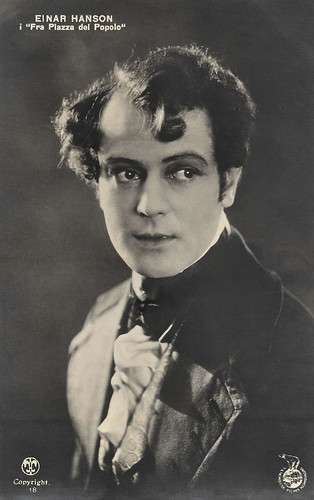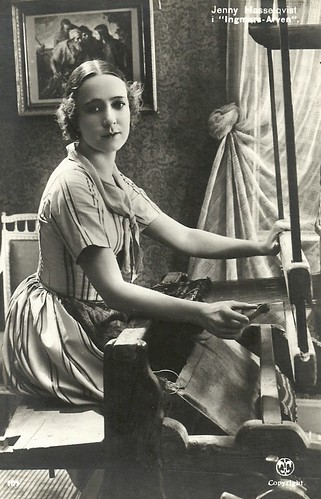María Mercader (1918-2011) was a Spanish actress who acted in Spanish and Italian films, largely between 1939 and 1952. She was the second wife of Vittorio De Sica and the mother of Christian and Manuel De Sica.
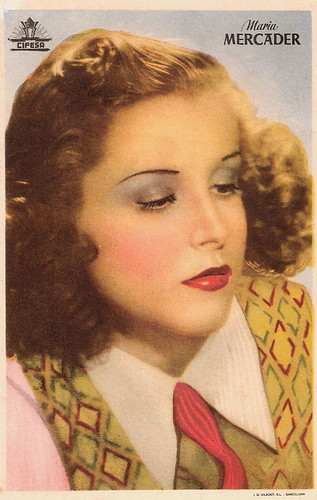
Spanish collector card by Cifesa / I.G. Viladot Sil, Barcelona.

Italian postcard by Gli attori della Tirrenia Cinematografica, no. 1. Maria Mercader in Brivido / Thrill (Giacomo Gentilomo, 1941).

Italian postcard by Stab. Angel, Terni / A. Terzoli, Roma, no. 311. Photo: Villoresi.
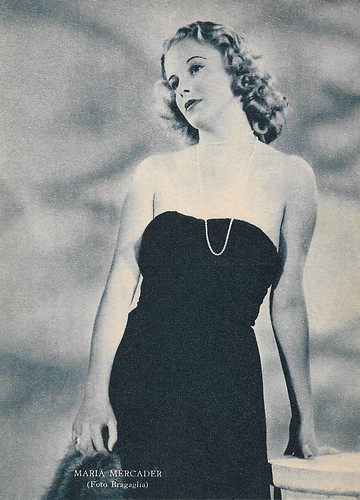
Italian postcard by Rizzoli & C., Milano, 1942. Photo: Bragaglia.
María Mercader Forcada was born in Barcelona, Spain, in 1918. Her cousin was Ramón Mercader, the murderer of Leon Trotsky in 1940, in Mexico. As a young girl, Mercader already had a minor part in the Spanish silent film La bruja / The Witch (Maximiliano Thous, 1923), but her film career really took off in 1939 when she acted in the Spanish musical Molinos de viento / Windmills (Rosario Pi, 1939).
This was followed by her acting in the French crime film L’étrange nuit de Noël / The Strange Christmas Night (Yvan Noë, 1939), starring Pierre Alcover and Sylvia Bataille. In the same year, she started to act in Italian films, probably first in Il segreto inviolabile / The Unbreakable Secret (1939), shot at the Titanus studios in Rome but directed by her Spanish compatriot Julio (de) Fleischner, and with another compatriot, José Nieto, as the male star of the film. It was the alternate-language version of the Spanish film Su mayor aventura / >His Greatest Adventure (Julio de Fleischner, 1940).
This set off a huge string of Italian films during the war years, directed by ‘routiniers’ such as Mario Bonnard (La gerla di papa Martin / Disillusion, 1941; Il re si diverte / The King's Jester, 1941) and Carlo Ludovico Bragaglia (La forza bruta / Brute Force, 1941; Il prigioniero di Santa Cruz / The prisoner of Santa Cruz, 1941; Una famiglia impossibile / An Impossible Family, 1941; Due cuori di sequestro / Two Hearts Under Seizure, 1941; Se io fossi onesto / If I Were Really Honest, 1942), but also films directed by Giacomo Gentilomo (Brivido / Thrill, 1941) and Luigi Zampa (L’attore scomparso / The Actor Died, 1941).
In Il prigioniero di Santa Cruz, Mercader played opposite her compatriot Juan De Landa, who later played Bragana in Luchino Visconti’s Ossessione (1943). With Michel Simon and Rossano Brazzi, the stars of Tosca (Jean Renoir, Carl Koch, 1941), she acted in the Rigoletto adaptation Il re si diverte / The King's Jester (Mario Bonnard).
Her co-actors in those years were generally established actors such as Ruggero Ruggeri and Armando Falconi, but also such young, upcoming stars as Massimo Serato, Roberto Villa and Leonardo Cortese, and female stars such as Vivi Gioi and Doris Duranti. María Mercader occasionally acted in Spanish films as well.

Italian postcard by A. Scarmiglia Edizioni, Roma (ASER), no. 105. Photo: Bragaglia, Atlas Film.

Italian postcard by ASER, no. 121. Photo: Pesce. Sent by mail in 1943.

Italian postcard by ASER, no. 217. Photo: Gneme / Incine, Tirrenia.

Italian postcard by ASER, no. 304. Photo: Vaselli / Lux Film.

Romanian postcard.
In 1942, on the set of the comedy Un garibaldino al convent / A Garibaldian in the Convent, María Mercader met the director of the film, Vittorio De Sica. He fell madly in love with her, though De Sica was married to actress Giuditta Rissone.
Mercader and De Sica immediately after this production acted together in the comedy Se io fossi onesto / If I were really honest (Carlo Ludovico Bragaglia, 1942). They were paired again in Non sono superstizioso...ma! / I'm not superstitious ... but! (Carlo Ludovico Bragaglia, 1943) and I nostri sogni / Our Dreams (Vittorio Cottafavi, 1943).
Nevertheless, in those war years Mercader acted in many more films without De Sica than with him. These included Finalmente soli! / Finally Alone (Giacomo Gentilomo, 1942) with Enrico Viarisio, Musica proibita / Forbidden Music (Carlo Campogalliani, 1942) with singer Tito Gobbi, Il treno crociato / The Red Cross Train (Carlo Campogalliani, 1943) with Rossano Brazzi, La vita è bella / Life is Beautiful (Carlo Campogalliani, 1943) with singer Alberto Rabagliati and rising star Anna Magnani, and La primadonna (Ivo Perilli, 1943) with Anneliese Uhlig.
She was also one of the female all-star cast of Nessuno torna indietro / Responsibility Comes Back (Alessandro Blasetti, 1943), co-starring Elisa Cegani, Valentina Cortese, María Denis, Doris Duranti and Mariella Lotti.
During the German occupation of Rome and the Repubblica sociale di Salò, Mercader didn’t join the fascist industry in Venice, so her film acting stopped.

Italian postcard by Ballerini & Fratini Editori (B.F.F. Edit.), Firenze, no. 4351. Photo: Pesce / ENIC.

Italian postcard by B.F.F. Edit., no. 4461, 1943. Photo: Bragaglia / LUX Film.

Italian postcard by B.F.F. Edit., no. 4466, 1943. Photo: Bragaglia / LUX Film.

Italian postcard by B.F.F. Edit., no. 21830. Photo: Bragaglia / I.C.I.
After the Liberation of Rome, María Mercader renewed her film acting career and became a leading pair again with Vittorio De Sica in L’ippocampo / The Hippocampus (Gianpaolo Rosmino, 1945). She also had a supporting part in De Sica’s own film La porta del cielo / The Gate of Heaven (Vittorio De Sica, 1945), starring Marina Berti and Massimo Girotti.
After Il canto della vita / The Song of Life (Carmine Gallone, 1945), starring Alida Valli, she played a minor part in Natale in campo 119 / Christmas at Camp 119 (Pietro Francisci, 1947). Mercader played Clotilda Serra opposite De Sica and the upcoming actor Giorgio De Lullo in the Edmondo De Amicis adaptation Cuore / Heart and Soul (1948), which De Sica co-directed with Duilio Coletti.
After a lead in the period piece Il cavaliere misterioso / The Mysterious Cavalier (Riccardo Freda, 1948), with Vittorio Gassman as Casanova, Mercader stayed away from the screen until 1952, when she was paired with De Sica again in Buongiorno elefante! / Hello Elephant (Gianni Franciolini, 1952), scripted by Suso Cecchi D’Amico and Cesare Zavattini. After that, only incidental performances followed, such as Christian De Sica’s mother in Giovannino (Paolo Nuzzi, 1976).
In 1988, she acted in La casa del sorriso / The House of Smiles by Marco Ferreri, which won the Golden Bear in Berlin in 1991. It was the last Italian film to win in Berlin before Cesare deve morire / Caesar Must Die by the Taviani brothers. Other cameo appearances Mercader had in Claretta (Pasquale Squitieri, 1984), Il conte Max / Count Max (1991) by her son Christian De Sica - a remake of his father’s comedy Il signor Max / Mister Max (Mario Camerini, 1937), and Al lupo, al lupo / Wolf! Wolf! (Carlo Verdone, 1992).
All in all, she acted in some 40 films between 1923 and 1992. In 1959, Mercader and De Sica married in Mexico, after his divorce from Rissone, but Italian law did not recognise the divorce nor the marriage, so once he obtained French citizenship in 1968, Mercader married De Sica again in Paris. She became the mother of composer Manuel De Sica (1949) and actor and director Christian De Sica (1951). While De Sica died in Neuilly near Paris in 1974, Maria Mercader died in Rome in 2011, at the age of almost 93 years. In 1978, her autobiography 'La mia vita con Vittorio De Sica' (My Life with Vittorio De Sica) appeared, which was also distributed in Spanish (1980) and French (1981).
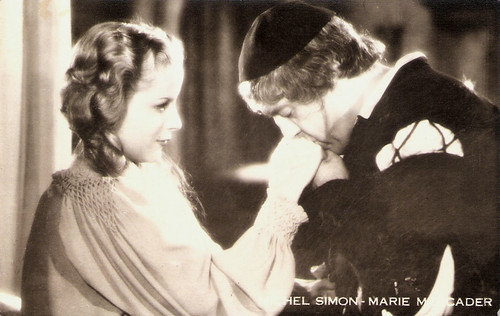

Spanish collector card by Cifesa / I.G. Viladot Sil, Barcelona.

Italian postcard by Gli attori della Tirrenia Cinematografica, no. 1. Maria Mercader in Brivido / Thrill (Giacomo Gentilomo, 1941).

Italian postcard by Stab. Angel, Terni / A. Terzoli, Roma, no. 311. Photo: Villoresi.

Italian postcard by Rizzoli & C., Milano, 1942. Photo: Bragaglia.
Italian films
María Mercader Forcada was born in Barcelona, Spain, in 1918. Her cousin was Ramón Mercader, the murderer of Leon Trotsky in 1940, in Mexico. As a young girl, Mercader already had a minor part in the Spanish silent film La bruja / The Witch (Maximiliano Thous, 1923), but her film career really took off in 1939 when she acted in the Spanish musical Molinos de viento / Windmills (Rosario Pi, 1939).
This was followed by her acting in the French crime film L’étrange nuit de Noël / The Strange Christmas Night (Yvan Noë, 1939), starring Pierre Alcover and Sylvia Bataille. In the same year, she started to act in Italian films, probably first in Il segreto inviolabile / The Unbreakable Secret (1939), shot at the Titanus studios in Rome but directed by her Spanish compatriot Julio (de) Fleischner, and with another compatriot, José Nieto, as the male star of the film. It was the alternate-language version of the Spanish film Su mayor aventura / >His Greatest Adventure (Julio de Fleischner, 1940).
This set off a huge string of Italian films during the war years, directed by ‘routiniers’ such as Mario Bonnard (La gerla di papa Martin / Disillusion, 1941; Il re si diverte / The King's Jester, 1941) and Carlo Ludovico Bragaglia (La forza bruta / Brute Force, 1941; Il prigioniero di Santa Cruz / The prisoner of Santa Cruz, 1941; Una famiglia impossibile / An Impossible Family, 1941; Due cuori di sequestro / Two Hearts Under Seizure, 1941; Se io fossi onesto / If I Were Really Honest, 1942), but also films directed by Giacomo Gentilomo (Brivido / Thrill, 1941) and Luigi Zampa (L’attore scomparso / The Actor Died, 1941).
In Il prigioniero di Santa Cruz, Mercader played opposite her compatriot Juan De Landa, who later played Bragana in Luchino Visconti’s Ossessione (1943). With Michel Simon and Rossano Brazzi, the stars of Tosca (Jean Renoir, Carl Koch, 1941), she acted in the Rigoletto adaptation Il re si diverte / The King's Jester (Mario Bonnard).
Her co-actors in those years were generally established actors such as Ruggero Ruggeri and Armando Falconi, but also such young, upcoming stars as Massimo Serato, Roberto Villa and Leonardo Cortese, and female stars such as Vivi Gioi and Doris Duranti. María Mercader occasionally acted in Spanish films as well.

Italian postcard by A. Scarmiglia Edizioni, Roma (ASER), no. 105. Photo: Bragaglia, Atlas Film.

Italian postcard by ASER, no. 121. Photo: Pesce. Sent by mail in 1943.

Italian postcard by ASER, no. 217. Photo: Gneme / Incine, Tirrenia.

Italian postcard by ASER, no. 304. Photo: Vaselli / Lux Film.

Romanian postcard.
Madly in love
In 1942, on the set of the comedy Un garibaldino al convent / A Garibaldian in the Convent, María Mercader met the director of the film, Vittorio De Sica. He fell madly in love with her, though De Sica was married to actress Giuditta Rissone.
Mercader and De Sica immediately after this production acted together in the comedy Se io fossi onesto / If I were really honest (Carlo Ludovico Bragaglia, 1942). They were paired again in Non sono superstizioso...ma! / I'm not superstitious ... but! (Carlo Ludovico Bragaglia, 1943) and I nostri sogni / Our Dreams (Vittorio Cottafavi, 1943).
Nevertheless, in those war years Mercader acted in many more films without De Sica than with him. These included Finalmente soli! / Finally Alone (Giacomo Gentilomo, 1942) with Enrico Viarisio, Musica proibita / Forbidden Music (Carlo Campogalliani, 1942) with singer Tito Gobbi, Il treno crociato / The Red Cross Train (Carlo Campogalliani, 1943) with Rossano Brazzi, La vita è bella / Life is Beautiful (Carlo Campogalliani, 1943) with singer Alberto Rabagliati and rising star Anna Magnani, and La primadonna (Ivo Perilli, 1943) with Anneliese Uhlig.
She was also one of the female all-star cast of Nessuno torna indietro / Responsibility Comes Back (Alessandro Blasetti, 1943), co-starring Elisa Cegani, Valentina Cortese, María Denis, Doris Duranti and Mariella Lotti.
During the German occupation of Rome and the Repubblica sociale di Salò, Mercader didn’t join the fascist industry in Venice, so her film acting stopped.

Italian postcard by Ballerini & Fratini Editori (B.F.F. Edit.), Firenze, no. 4351. Photo: Pesce / ENIC.

Italian postcard by B.F.F. Edit., no. 4461, 1943. Photo: Bragaglia / LUX Film.

Italian postcard by B.F.F. Edit., no. 4466, 1943. Photo: Bragaglia / LUX Film.

Italian postcard by B.F.F. Edit., no. 21830. Photo: Bragaglia / I.C.I.
A leading pair again
After the Liberation of Rome, María Mercader renewed her film acting career and became a leading pair again with Vittorio De Sica in L’ippocampo / The Hippocampus (Gianpaolo Rosmino, 1945). She also had a supporting part in De Sica’s own film La porta del cielo / The Gate of Heaven (Vittorio De Sica, 1945), starring Marina Berti and Massimo Girotti.
After Il canto della vita / The Song of Life (Carmine Gallone, 1945), starring Alida Valli, she played a minor part in Natale in campo 119 / Christmas at Camp 119 (Pietro Francisci, 1947). Mercader played Clotilda Serra opposite De Sica and the upcoming actor Giorgio De Lullo in the Edmondo De Amicis adaptation Cuore / Heart and Soul (1948), which De Sica co-directed with Duilio Coletti.
After a lead in the period piece Il cavaliere misterioso / The Mysterious Cavalier (Riccardo Freda, 1948), with Vittorio Gassman as Casanova, Mercader stayed away from the screen until 1952, when she was paired with De Sica again in Buongiorno elefante! / Hello Elephant (Gianni Franciolini, 1952), scripted by Suso Cecchi D’Amico and Cesare Zavattini. After that, only incidental performances followed, such as Christian De Sica’s mother in Giovannino (Paolo Nuzzi, 1976).
In 1988, she acted in La casa del sorriso / The House of Smiles by Marco Ferreri, which won the Golden Bear in Berlin in 1991. It was the last Italian film to win in Berlin before Cesare deve morire / Caesar Must Die by the Taviani brothers. Other cameo appearances Mercader had in Claretta (Pasquale Squitieri, 1984), Il conte Max / Count Max (1991) by her son Christian De Sica - a remake of his father’s comedy Il signor Max / Mister Max (Mario Camerini, 1937), and Al lupo, al lupo / Wolf! Wolf! (Carlo Verdone, 1992).
All in all, she acted in some 40 films between 1923 and 1992. In 1959, Mercader and De Sica married in Mexico, after his divorce from Rissone, but Italian law did not recognise the divorce nor the marriage, so once he obtained French citizenship in 1968, Mercader married De Sica again in Paris. She became the mother of composer Manuel De Sica (1949) and actor and director Christian De Sica (1951). While De Sica died in Neuilly near Paris in 1974, Maria Mercader died in Rome in 2011, at the age of almost 93 years. In 1978, her autobiography 'La mia vita con Vittorio De Sica' (My Life with Vittorio De Sica) appeared, which was also distributed in Spanish (1980) and French (1981).

Italian or Romanian postcard. Maria Mercader and Michel Simon in Il re si diverte (Mario Bonnard, 1941).

Romanian postcard. Maria Mercader and Massimo Serato in Due cuori sotto sequestro (Carlo Ludovico Bragaglia, 1941).

Romanian postcard. Foto: Criterion Romanesc. Maria Mercader and Leonardo Cortese in probably Un garibaldino al convento/ A Garibaldian in the Convent (Vittorio De Sica, 1942).

Romanian postcard. Maria Mercader and Guido Lazzarini in probably the Italian film La fanciulla dell'altra riva (Piero Ballerini, 1942). Lazzarini's name is misspelt on this card.
Sources: Wikipedia (French, Italian, Spanish, German and English) and IMDb. Additional information by Marlene Pilaete.
















